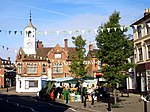Ampthill Tunnel

Ampthill tunnel is a railway tunnel at Ampthill on the Midland Main Line, being positioned between Bedford and Flitwick. It consists of two separate bores, each one accommodating double-track throughout. The first Ampthill Tunnel was built during the 1860s; growing demand on the line led to the original double-track configuration being inadequate for further growth. Thus, during the 1890s, a second Ampthill Tunnel was constructed directly alongside, facilitating the Midland Railway's expansion plans of running a quadruple-track arrangement between Kettering and London wherever practical to do so. Both bores have remained active through to the present day. During mid 2012, Ampthill Tunnel was subject to a series of high speed evaluation runs, including a record maximum speed for the route of 125 miles per hour (201 km/h); in the following year, the line speeds were increased to 125 mph along much of the Midland Main Line.
Excerpt from the Wikipedia article Ampthill Tunnel (License: CC BY-SA 3.0, Authors, Images).Ampthill Tunnel
Woburn Road,
Geographical coordinates (GPS) Address Nearby Places Show on map
Geographical coordinates (GPS)
| Latitude | Longitude |
|---|---|
| N 52.033611111111 ° | E -0.51333333333333 ° |
Address
Woburn Road
Woburn Road
MK45 2HX
England, United Kingdom
Open on Google Maps





